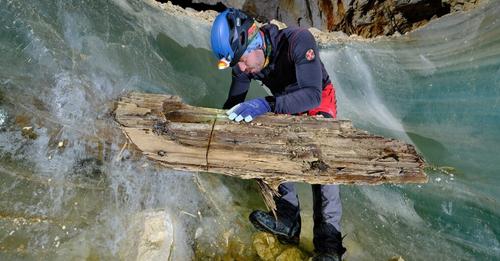Slovenian ice caves disappearing fast
Slovenia has a number of ice caves, but due to climate change ice volumes are dwindling fast along with the information that has accumulated for thousands of years. Researchers hope to extract as much knowledge as possible before it is too late.
"In the past 10 to 20 years, we have seen exponential rate of ice loss," says researcher Jure Tičar, whose team at the Anton Melik Institute of Geography visits several of what are more than 230 ice caves in Slovenia twice a year.
They visit the caves in late spring, after the ice accumulation has stopped, and in early autumn, after the end of the melting period, with Tičar explaining that the increasing speed of melting is a consequence of higher temperatures and turbulent weather.
"Changes in the weather have an increasing effect on ice thawing and accumulation, therefore research is of paramount importance," says Tičar, who hopes that in the future his team will be able to expand their research to other caves.
Ice caves at lower altitudes hit hardest
Ice caves that lie at lower altitudes have virtually lost ice already. The only ice that can be found in these caves comes from the water that seeps into the cave during the colder periods of the year, says Tičar.
Data also shows that ice hardly accumulates at all during winter months, which is the case also in the Great Ice Cave in Paradana on the Trnovski Gozd plateau in western Slovenia, the entrance of which is located at an altitude of 1,100 metres.
Laser scanning analyses have shown that up to 50 centimetres of ice can be lost per melting season, but Tičar warns that some data are even worse.
"Last season, we saw up to 100 centimetres in the Ivačič Cave on Kredarica disappearing," he says of a location in the Julian Alps best known for a mountain hut at an altitude of over 2,500 metres, just below the country's highest peak, Mount Triglav.
Nearby, in the Triglav Ice Cave, a particularly deep ice cave, which used to be impassable due to immense volumes of ice, a 20-metre thick ice mass has melted completely, with its remains plunging into the depths.

A researcher at the Raduha ice cave. Photo: Anton Melik Institute of Geography Facebook profile
Meanwhile, measurements at the ice cave on Mount Raduha in northern Slovenia at over 1,500 metres of altitude have shown that the ice mass has started to shift away from the rock face, leading to the emergence of crags, while the typical stalactites now form only rarely.
What is more, the fierce storms that devastated the area in August 2023 damaged the cave: the entrance was reshaped and a large volume of material forced its way into the cave.
Moreover, the Ice Cave at Planina Viševnik, a high-altitude pasture area in the Julian Alps at 1,600 metres above sea level, has lost over 100 cubic metres of ice in the past 15 years.
Information melting away
The disappearance of ice is devastating news for scientists hoping to extract from the ice important information about weather over the course of many millennia. Such information could also provide indicators about possible weather changes in the future.
Tičar says ice caves have been rather neglected compared to other bodies of ice and remain relatively poorly researched. So far only a total of 141 metres of ice profiles have been collected from ice caves around the world.
"Because ice in Karst caves, just like glaciers, responds rapidly to the current climate situation and is disappearing at high rates, valuable information and facts we are only beginning to uncover are literally disappearing before our eyes."
"There is relatively little data about climate in Slovenia in the past, especially in the high mountains, where entrances to ice caves are located. Therefore, any new finding is key to understanding the dynamics of natural processes in the past," Tičar says.
To learn as much as possible before it is too late, Tičar's team at the Anton Melik Institute of the Research Centre of the Slovenian Academy of Sciences and Arts (ZRC SAZU) hopes to expand their work to include more caves and areas, most of which are located in the high mountains.
The team samples ice for age, isotope and geochemical analysis, as well as microbiological research. Funded by the Research and Innovation Agency, their current project aims to provide an insight into Holocene weather and is running between 2023 and 2026.


